Your Customer Feedback Is a Goldmine. Stop Treating It Like a Landfill.
Discover the best customer feedback analysis tools in 2025 to boost insights, improve satisfaction, and accelerate your business growth. Explore now!
Posted by
Related reading
Stop Asking Useless Survey Questions. Steal These Instead.
Stop guessing. Get battle-tested survey questions examples to find out what your customers actually want. Real talk, no fluff. Just actionable insights.
Fix Your Customer Feedback Questionnaire Now
Revamp your customer feedback questionnaire with brutally honest advice. Get actionable insights and stop wasting your customers' time with bad surveys.
How to Collect Customer Feedback (Without Wasting Your Goddamn Time)
Stop guessing. Learn how to collect customer feedback that drives growth. A no-BS guide for founders on building products people actually want.
Let’s be honest. You’re probably sitting on a pile of NPS scores, survey responses, and App Store reviews, feeling proud of all the “data” you’ve collected. But you're not actually using it. You're hoarding it. It’s a digital landfill of good intentions. Your customers are practically handing you a treasure map to their wallets in support tickets and salty tweets, but you’re too busy building that one feature your lead developer thinks is cool.
Ignore your customers, and you’ll be lucky to survive the quarter.
This isn't another fluffy post about "the importance of listening." This is a founder-to-founder intervention. Your goal isn't to collect feedback; it's to extract brutal, profitable truths from the chaotic mess your users leave behind. Stop asking for permission to innovate. Start translating their rants into your roadmap.
Forget the enterprise-grade garbage pitched by sales reps who've never built a thing. Here’s a no-bullshit list of tools—the good, the bad, and the ugly—that actually get the job done.
The Problem with How You're Collecting Feedback Now
Before we get to the tools, let's call out the bad habits. You're probably using generic survey tools because they're easy. But easy is lazy.
1. SurveyMonkey
Everyone's used it. It’s the vanilla ice cream of feedback. It gets the job done if you need to ask 100 people if they prefer blue or red.
- The Drawback: It encourages you to ask leading, multiple-choice questions that give you clean charts but zero insight. You get confirmation bias, not truth. The free plan is a joke designed to frustrate you into a costly upgrade. It’s a tool for getting answers you already expect.
Takeaway: If you just need to prove a point with a pretty graph for a board meeting, fine. If you want to build a better product, it's a trap.
2. Typeform
It’s beautiful. It feels like a conversation. Your completion rates will soar. You’ll feel like a design genius.
- The Drawback: It's all sizzle, no steak. The analytics are cosmetic. You get high engagement but shallow data. Once you have the responses, you're back to square one: a spreadsheet full of open-ended text you have no time to read. You’re paying a premium for a prettier front door to the same messy garage.
Takeaway: Use it for lead gen or quizzes. For deep customer feedback analysis, it's lipstick on a pig.
3. Google Forms
It’s free. It’s simple. It’s also what your kid uses for their 5th-grade science project.
- The Drawback: Zero analytics. Zero intelligence. It dumps everything into a Google Sheet and wishes you the best of luck. You're not just the founder; you're now a full-time data-entry clerk, manually tagging and sorting comments until you want to throw your laptop out the window.
Takeaway: Using Google Forms for customer feedback signals that you value your time at $0/hour.
The Tools That Actually Work (And Their Flaws)
Alright, enough shaming. Let's talk about the sharp tools for smart founders. These platforms are built for analysis, not just collection.
1. Backsy.ai
If you’re tired of begging for feedback and getting polite, useless answers, Backsy.ai is the antidote. It's built on a simple, powerful premise: your best feedback comes when customers are either pissed off or delighted, not when you email them a survey a week later. It captures raw, unstructured feedback—voice notes, angry text rants, brilliant ideas—from anywhere, on their terms.
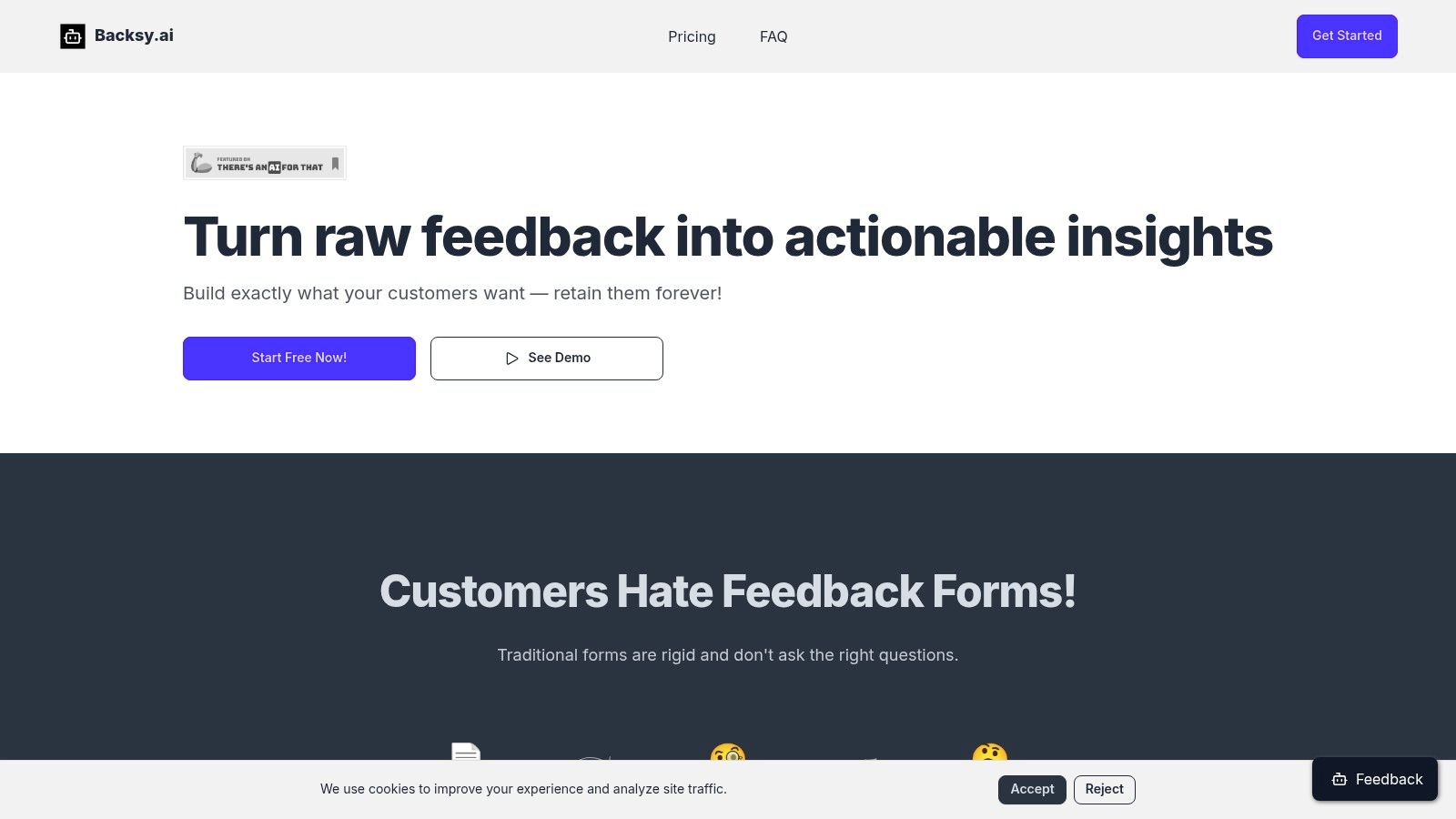
This isn’t another survey tool; it’s a listening engine. Its AI does the dirty work, sifting through the chaos to find the patterns—the bugs everyone hates, the features they'd actually pay for. It’s one of the few customer feedback analysis tools built for founders who prefer brutal honesty over polite lies.
The Catch: The credit-based system means you pay for what you analyze. If you get a flood of feedback, you'll burn through credits fast. Also, you can't delete submissions—a feature designed for data integrity that might drive control freaks insane.
Takeaway: The fastest way to turn customer rants into a prioritized product roadmap.
Website: https://backsy.ai
2. SentiSum
You're drowning in Zendesk tickets, Intercom chats, and Trustpilot reviews. SentiSum is your lifeguard. It plugs directly into your support channels and uses AI to automatically tag and analyze every conversation. It’s for finding the root cause of problems, not just hitting your "time to resolution" KPI.
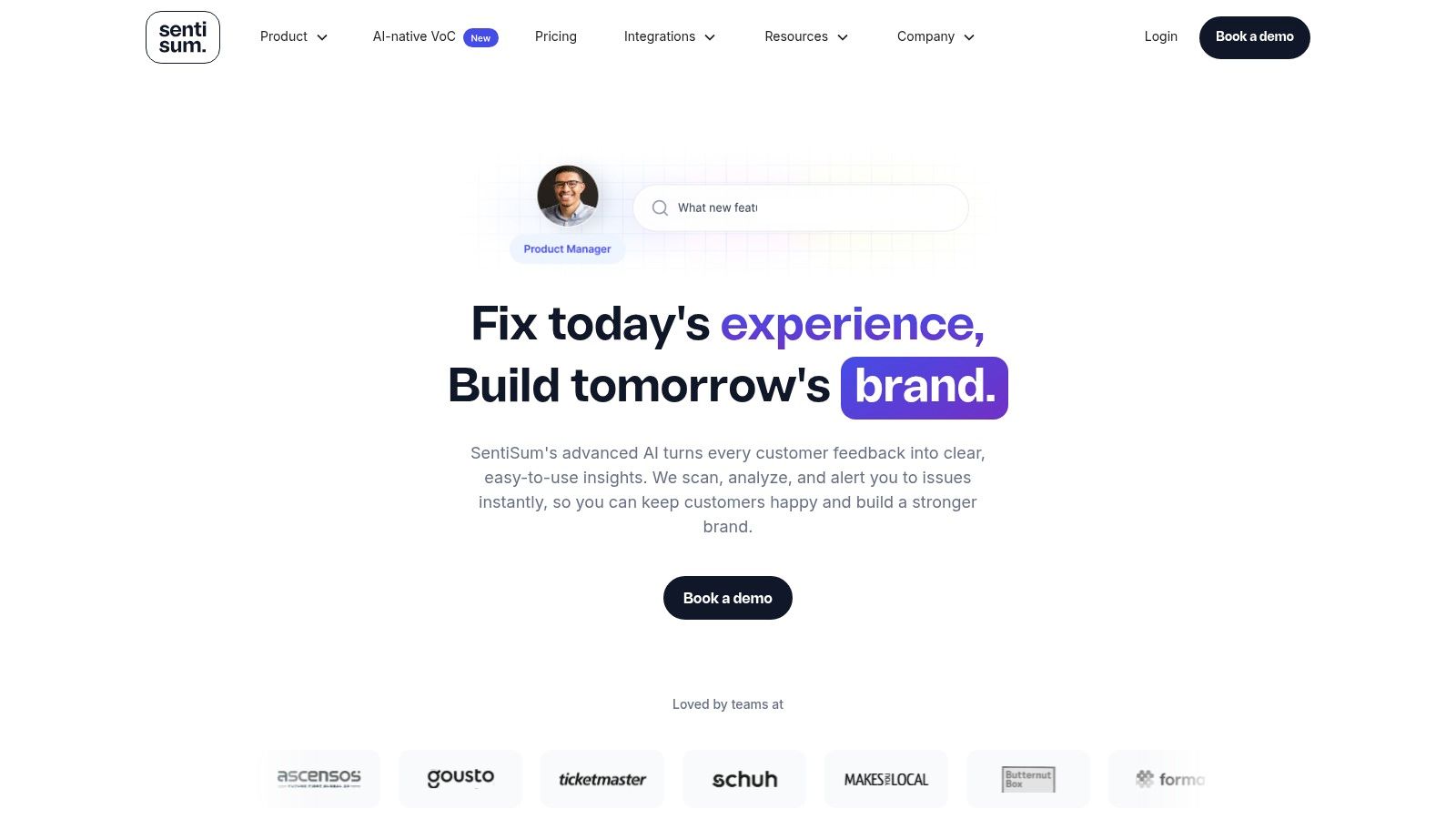
This is how you prove to your board that fixing that one confusing checkout step will cut support costs by 20%. It quantifies the pain.
The Catch: It's priced for teams with a real, high-volume pain point. If you only get a handful of support tickets a day, this is like using a firehose to water a houseplant. It's specialized for text-based support channels, so if your feedback lives elsewhere, look away.
Takeaway: Turns your cost-center support desk into a profit-driving intelligence unit.
Website: https://www.sentisum.com/
3. Hotjar
Hotjar is for watching your users fail. It’s brutally effective. You see exactly where they get stuck, where they rage-click, and where they give up. It combines session recordings and heatmaps with on-page feedback polls. You’re not just guessing why your conversion rate sucks; you’re watching the replay.
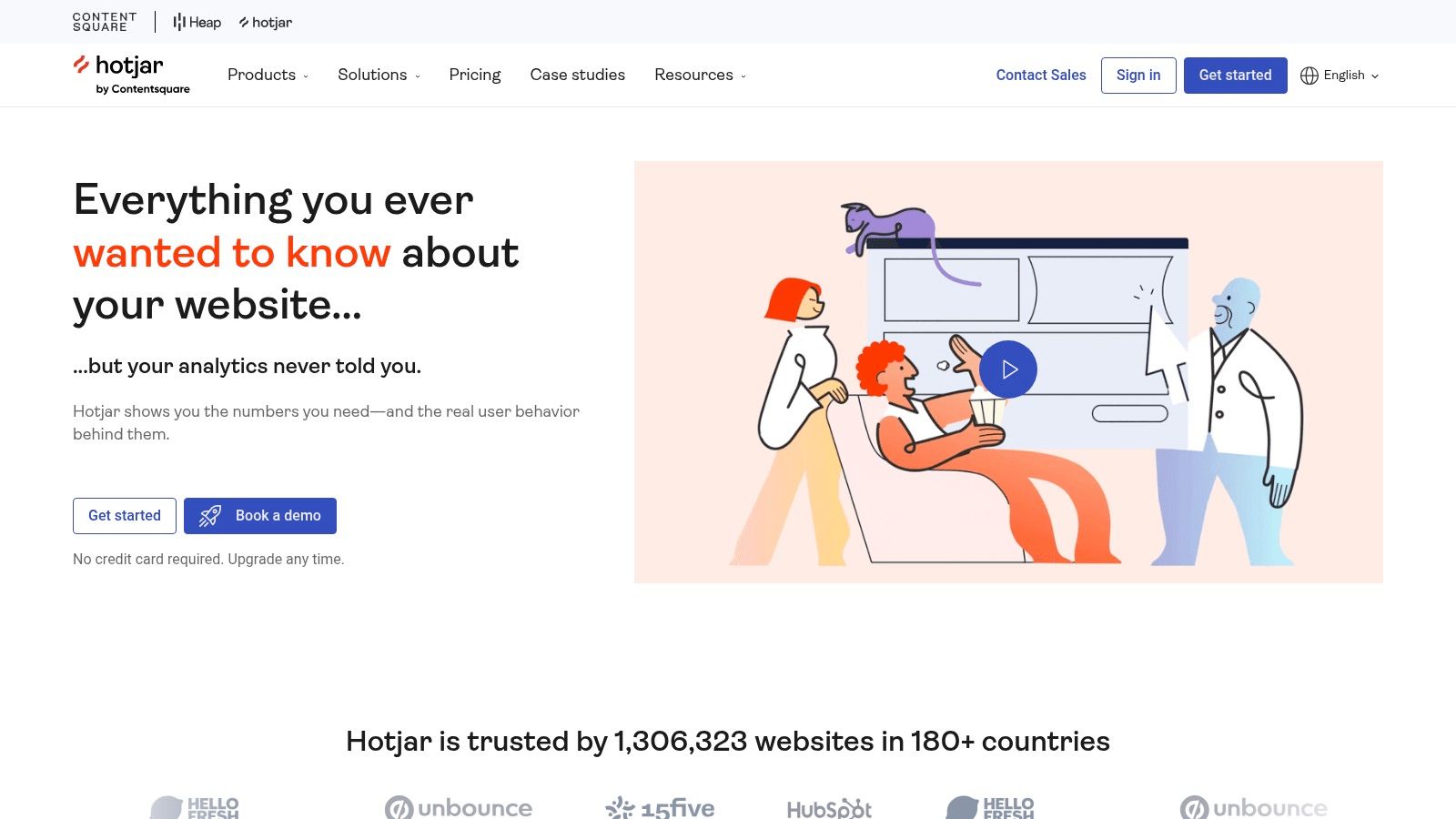
The magic is seeing a user struggle on a recording and immediately launching a poll on that page asking, "What were you looking for?" It’s undeniable, actionable evidence.
The Catch: The data is directional, not statistically bulletproof. It tells you what is broken, but not necessarily at scale. The pricing is based on sessions, so high-traffic sites will pay a premium. It’s a scalpel for UX problems, not a swiss-army knife for all feedback.
Takeaway: The closest you can get to standing over your customer’s shoulder and watching them use your product.
Website: https://www.hotjar.com/
4. MonkeyLearn
MonkeyLearn is for founders who want to build their own feedback-analysis machine without hiring a data scientist. It’s a no-code AI platform that you train to understand your business. You teach it to tag feedback by specific features, bugs, or whatever else matters. It turns your firehose of unstructured text into a clean, organized, and actionable database.
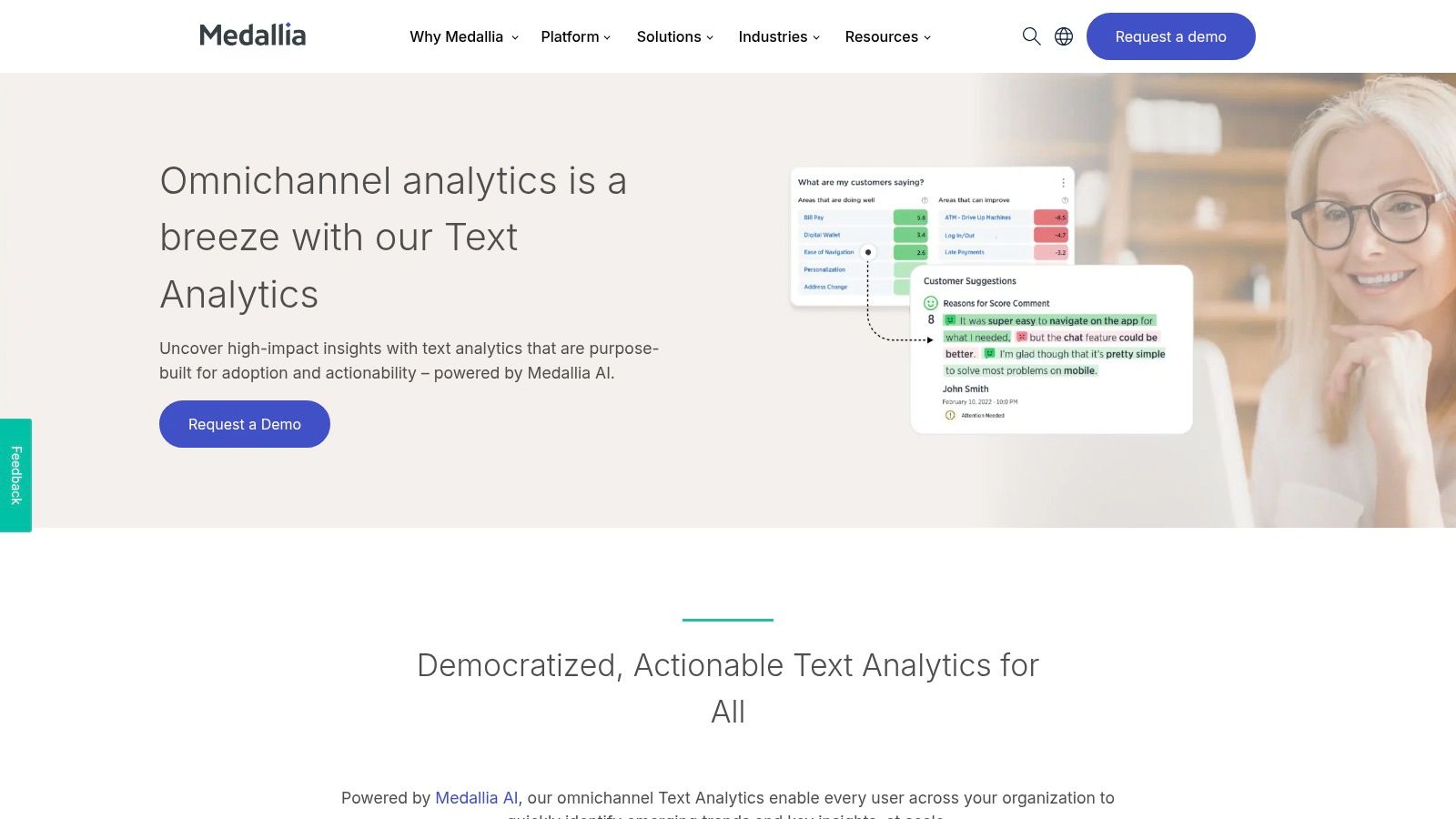
The Catch: "No-code" does not mean "no-work." The AI is only as smart as you make it. You have to put in the upfront effort of manually tagging hundreds of pieces of feedback to train your models. If you're not willing to do that initial grunt work, you'll get garbage results.
Takeaway: A powerful tool for control freaks who want a custom AI model without writing a line of code.
Website: https://monkeylearn.com/
5. Chattermill
Chattermill is the aggregator. It pulls in your Zendesk tickets, your App Store reviews, your survey responses—everything—and unifies it into a single view. It's built for the messy reality where feedback lives in a dozen different silos. Its AI connects the dots, identifying the themes that pop up across all your channels.
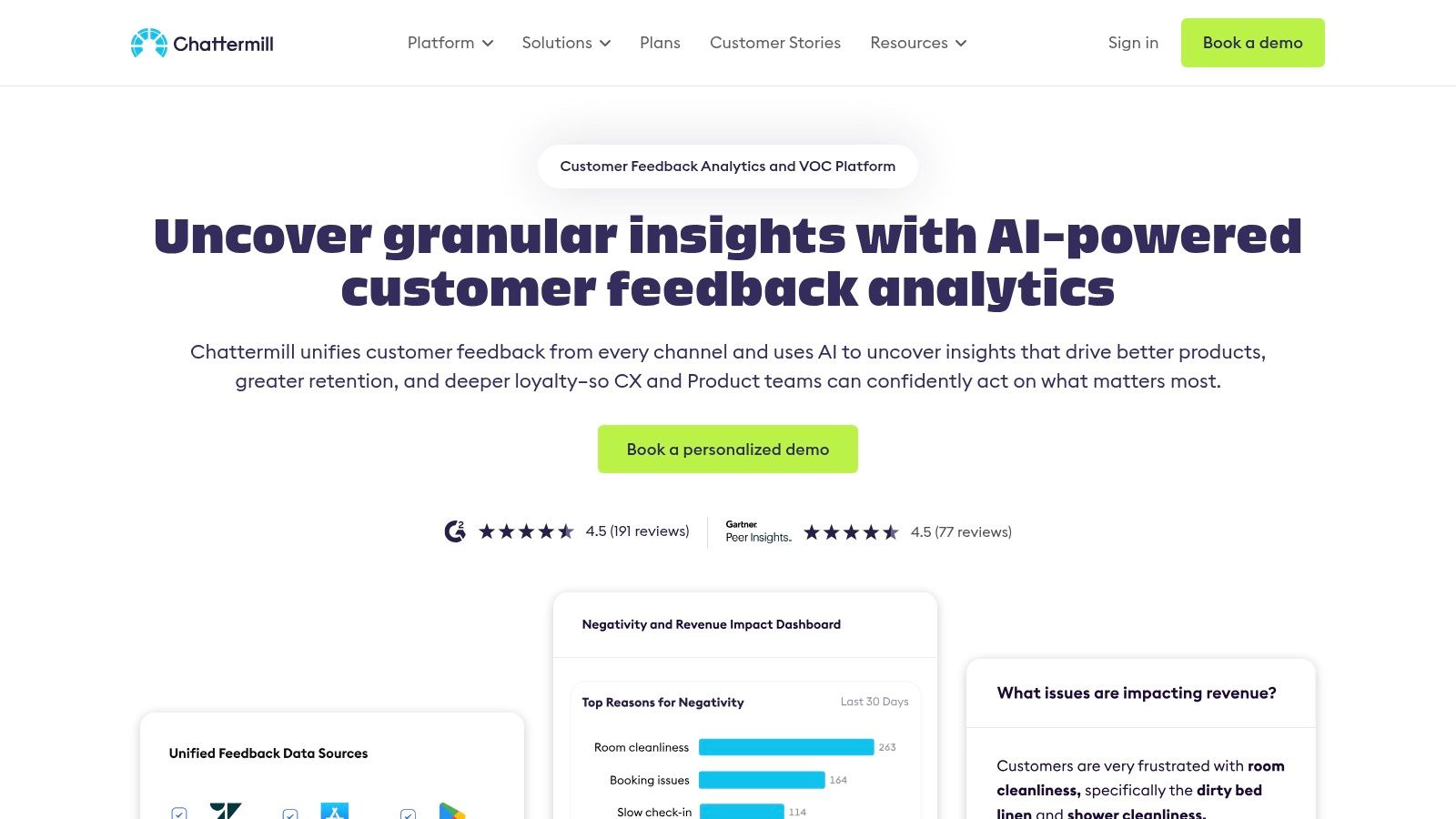
The Catch: It's an enterprise-grade tool with an enterprise-grade price tag. This is not for the faint of heart or light of wallet. If you don't have a massive, multi-channel feedback problem, buying Chattermill is like buying a freight train to commute to work.
Takeaway: The command center for companies drowning in feedback from too many places at once.
Website: https://chattermill.com/
Big Enterprise Sledgehammers (Handle With Care)
These tools are powerful, but for 99% of startups, they are expensive overkill. They are bought by committees, not founders. Proceed with caution.
- Qualtrics: (https://www.qualtrics.com/) The battleship of feedback. It's incredibly powerful, complex, and costs a fortune. Unless you have a dedicated research team and a six-figure budget, stay away.
- Medallia: (https://www.medallia.com/) Another enterprise beast. Great for mapping the entire customer journey in a global corporation. For a startup, it's like using a satellite to find your car keys. Get a Medallia demo if you enjoy seeing things you can't afford.
- AskNicely: (https://www.asknicely.com/) An expensive one-trick pony that’s obsessed with NPS. If your entire business model lives and dies by that one metric, maybe. Otherwise, you’re paying a premium for a very narrow view.
- Zendesk: (https://www.zendesk.com/) A fantastic ticketing system with decent, bolted-on survey features. The feedback analysis is an appetizer, not the main course. You're buying it for support, not for deep insights.
- Survicate: (https://survicate.com/) A solid swiss army knife for deploying surveys everywhere. It's a great collector, but the real deep analysis of that open-ended text is still your problem to solve.
Your Roadmap Is a Lie Without This
Stop debating. Pick a tool that matches your pain and your wallet, and commit. The goal isn't to find the perfect tool; it's to build the habit of turning customer complaints into your next competitive advantage.
Your product roadmap shouldn't be a work of fiction based on your gut feelings. It should be a direct, unapologetic response to what your customers are yelling about. Their pain is your profit. The answers are sitting right there in that digital landfill you've been ignoring.
Stop guessing. Stop asking polite questions. Start listening.
Stop exporting CSVs and wasting your life in spreadsheets—use Backsy.ai to find the money-making patterns in your customer feedback before your competitors do.